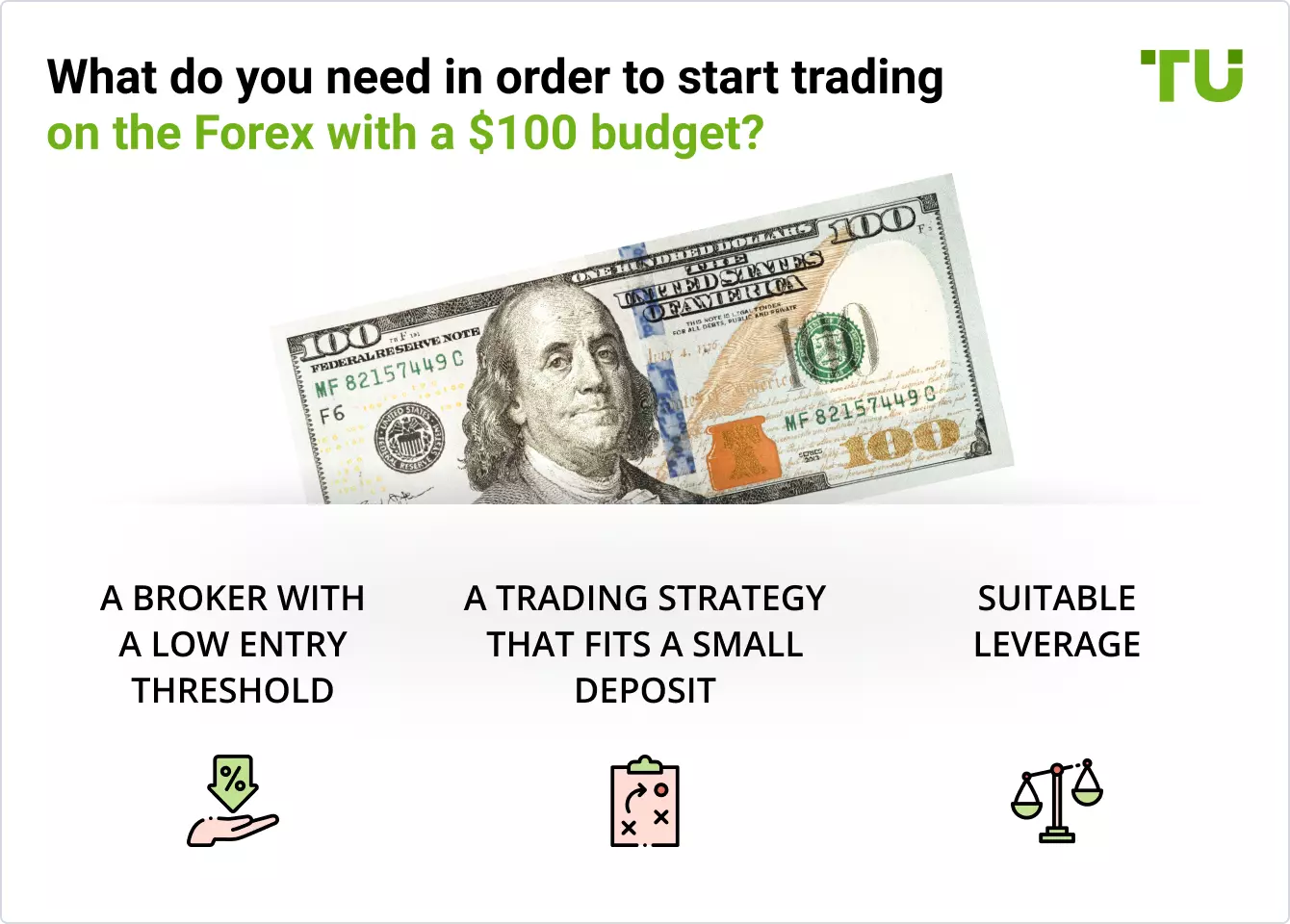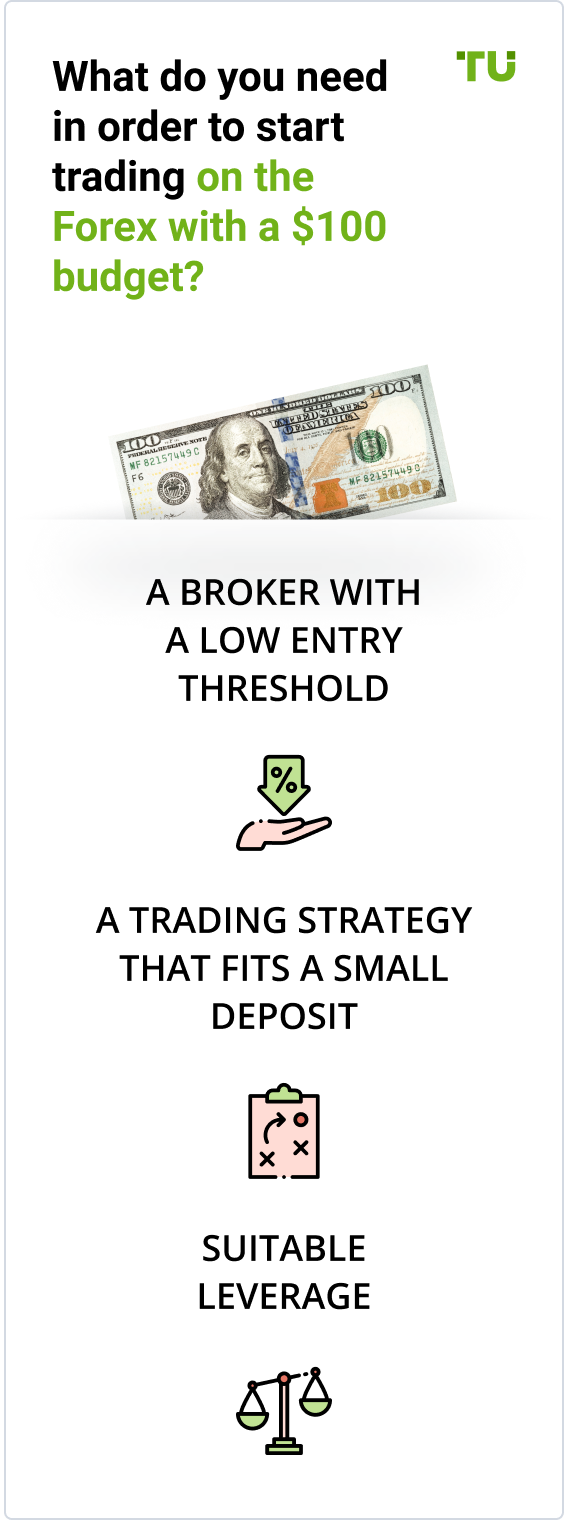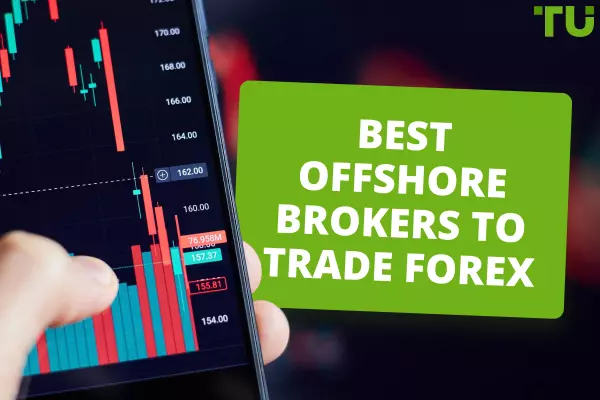How To Trade Forex With $100 – Beginner’s Guide
What if we told you it was possible to start trading forex with a little as $100? It certainly is, and in this post, we’ll show you how to trade Forex with $100. As a bonus, we’ll go one step further and give you a guide that will show you exactly what you need to start trading forex.
Interested in Forex Trading? Open a RoboForex Account

Can You Become a Forex Trader With Only $100?
The first question we’ll need to look at is whether you can become a trader with $100. Well, it’s certainly possible, but there are things you should consider. For one, you’ll have to find a broker that allows you to trade with $100. This is simply because many brokers require minimum deposits of more than $100.
So, why not just register with a broker where you only need $10? You certainly could, but there is often a major drawback with some of these brokers and the accounts they offer. Typically, to allow you to trade with such low amounts, they’ll often use significant leverage.
What is leverage? In simple terms, it’s when the broker loans you money to execute a trade. In turn, this then allows you to trade larger positions and, by implication, make more profit. Let’s explain with an example.
Let’s say you open a trading account and deposit $1,000. Now, let’s assume the account offers leverage of 100:1. This leverage means that the trade size is amplified by 100 times. In turn, this then means you’ll be able to effectively trade $100,000 of a specific currency pair with your $1,000 deposit.
When you execute a trade like this, you’ll then make a profit based on the $100,000 trade and not your $1,000 deposit. In other words, it amplifies your profits. This sounds great, doesn’t it? Well, it could be, but there is a significant drawback. Just like it’s able to amplify your profits, leverage can also greatly amplify your losses.
So, ideally, when you use leverage, risk management becomes even more important, and you’ll need to implement a strict trading style that includes using stop-loss orders to limit any loss you could make.
Is Trading With $100 a Good Idea?
While you won’t be able to make a living trading with $100, at least not until you grow your account significantly, it does offer one major benefit. When you trade with $100, you’ll be able to test strategies, practice proper risk management, and test the functionality of the trading platform without risking substantial amounts of money.
But can’t you do this with a demo account as well? Sure, but trading with real money also brings emotions and psychology into the equation. And this is a vital component of successful forex trading that you’ll need to learn and practice. In simple terms, with a demo account, you’ve got nothing to lose, so you won’t practice these.
How Does It Work? Real-Life Example
To show you how to trade with $100, we’ll look at a simple example. So, in contrast to our earlier example, your deposit here is 10 times lower. As a result, you’ll need to consider using substantial leverage that would enable you to execute trades. Like above, we’ll therefore once again use leverage of 1:100.
This leverage is the ideal midpoint between 1:50 which is a bit more conservative and 1:200 which is more aggressive. Anything above this leverage increases your risk too much and lower will reduce the profit you can potentially make substantially.
Now, let’s say you trade the USD/CAD currency pair. A standard lot would then be 100,000 units or worth $100,000. With your leverage, a standard lot would then require a margin of $1,000 which is still more than your deposit. So, how can you trade with your $100?
Well, the answer lies in the minimum lot sizes a broker offers. Here, some brokers offer minimum lot sizes of 0.1 lots with some even offering minimum lot sizes of 0.01 lots. These lot sizes will then enable you to trade effectively with a low deposit. For example, opening a position with a 0.01 lot size would require $1,000 or $10 with leverage.
Step 1. Learn Forex Trading Platform With A Demo Account
To properly prepare for engaging in Forex trading with limited capital, one must first utilize the learning tools provided. Wise traders take advantage of demo trading accounts to familiarize themselves with the interactive platform in a risk-free manner. Navigating an imitation environment allows newcomers to acclimate before managing live exchanges.
Begin by visiting the website of your preferred brokerage firm. Look for an option to "Open a Demo Account" or "Register for a Demo". Provide the requisite identification information and download the software on your desktop or mobile device - MetaTrader 4 and 5 tend to be the most widely used.
Upon logging in, you will be presented with simulated funds, typically in the range of $10,000 to $100,000 USD equivalent. This facilitates placing orders devoid of limitations, allowing you to familiarize yourself with platform functionality. Take the time to thoroughly explore the available analytical and trading tools. Discern arrangements for charts, order types, and account metrics.
Beyond understanding technical functions, demo trading offers invaluable practice implementing diverse strategies. Experiment with indicators, patterns, and approaches to gauge entry and exit points under varied scenarios. Place both hypothetical winning and losing trades to learn how different strategies hold up in different market conditions.
Refine and test strategies until you have confidence they can be consistently profitable. Full mastery of the demonstration environment and development of a viable strategy is pivotal prior to initiating real money transactions. This mitigates risks and ensures a smoother adjustment once transitioning from practice to production.
Step 2. Open a Trading Account
When you’ve practiced enough with your demo account, you’ll move on to trading with a real trading account. Remember, when you opened your demo account, a trading account was opened automatically.
In some instances, though, you’ll want to create a new trading account. Here, you’ll click on Accounts in the sidebar and then on the Trading Accounts tab. From here, you’ll click on Create new account.
On the next screen, you’ll select MT4 as the account type, leverage of 1:100, and USD as the Account Base Currency. You can then click on Create. Just like before, on the next screen, you’ll see a summary of your trading accounts, including the one you just opened.
Best brokers


Step 3. Fund Your Account
Before you can start trading, you’ll need to fund your account. To do this, you’ll click on Accounts in the sidebar and the Trading Accounts tab as before. You’ll then click on Fund to fund the trading account you want to use. Here, we’ll fund the account you created in the previous steps.
On the next screen, you can then select your funding method from the available options. These options include credit card, PayPal, Skrill, Neteller, or bank transfer. You also have the option of clicking Wallet in the sidebar and fund your account from there.
There you go, now you not only know how to open a demo account, but also a trading account and how to fund it.
Step 4. Think About Your Forex Strategy
Before you start trading, you’ll need to think about the strategy you’ll want to use. And here things can get complicated, simply because there are so many strategies you can choose from depending on your goals and risk appetite.
Typically, you can use some of the following strategies:

Day trading. When day trading, you’ll open and close positions during the same day, so you’ll never keep positions open overnight. In doing so, you’ll aim to capitalize on price movements during the day. This, in turn, allows you to react to market events more flexibly compared to strategies where you’ll keep positions open for longer. For this reason, it’s one of the most popular trading strategies among traders.

Swing trading. With swing trading, you’ll keep positions open for longer than day trading and aim to capitalize on longer-term trends in the market. Typically, you’ll open a buy or sell position when a trend starts to emerge and close it when the trend reverses.

Scalping. With scalping, you’ll open and close many positions throughout the day over short periods of time. The main aim with scalping is not to make one or two large profits but rather to make many small profits that all add up. In other words, scalpers aim to capitalize on frequent, small price movements in a specific currency.
Now, you might wonder which of these are the most popular? According to our research, it appears that there is no single strategy that all traders choose. In other words, there’s no one-size-fits-all approach, and traders choose the right strategy for them depending on what they want to achieve.
So, for example, our research shows that 31% of traders prefer swing trading while 27% prefer day trading.

Strategies by the Period of Holding Open Position
No matter what strategy you choose, it’s vital that you use proper market analytics. Now, this could be in the form of fundamental analysis, technical analysis, or a combination of the two. Fundamental analysis involves monitoring macroeconomic news and react based on the news.
Conversely, technical analysis relies on considering several indicators like volatility, support and resistance, and trends to forecast what the markets will do. On this basis, you’ll then open and close trades to capitalize on volatility or trends. When you combine the two, you’ll typically use fundamental analysis as the key indicator to open a position and technical analysis to confirm the indicator.
What Strategy To Choose?
As stated before, the strategy you choose depends on your trading goals and risk appetite. Each of the trading strategies mentioned above has pros and cons you’ll need to consider.
For example, while day trading does give you more flexibility to open and close positions to capitalize on news and shorter-term trends, it does carry more risk in some instances. It also requires more active trading with more positions open at any one time, which, in turn, increases pressure and makes it more challenging to manage, especially if you’re a beginner.
Conversely, swing trading allows you to open fewer trades which makes it easier to manage these trades. Keep in mind, though, that swing trading isn’t as effective in sideways markets or markets that move within a limited range.
Another thing you should consider is that, with strategies that require more frequent trades, you’ll also pay more commissions or spreads which, ultimately, reduce your profits. This is a very important consideration, especially when you’re trading with a small account.
So, although you can choose any strategy that fits your needs, our advice is to stick to swing trading when you trade with $100. In this way, you’ll only make several trades a week which makes it easier to manage and learn more while also allowing you to save on trading costs.
Forex Strategy Example – Swing Trading
As mentioned before, your aim with swing trading is to make a profit from longer-term trends in the market. To illustrate the strategy in practice, we’ll use a simple example using the EUR/USD currency pair.
To pick up the trend, we’ll use a simple moving average crossover strategy. Here, we’ll use the 9 MA and 20 MA moving averages. These numbers simply mean that the moving averages are calculated over the mentioned periods. So, the 9 AM means that the average price is calculated over the preceding 9 periods. For a day chart, this would mean over the preceding 9 days.
In our chart below which is based on the daily chart, the 9 MA is indicated as a blue line and the 20 MA is indicated as a yellow line. For this strategy, your entry point will be when the blue line crosses from below over the yellow line which indicates a change in trend and that the trend is likely to go up.
Likewise, your exit point will be when the blue line reverses and crosses over the blue line from above. This indicates that the trend is reversing and is likely going down. When you open and close your position based on these entry and exit points, you’ll then follow the trend upwards and make a profit.
To confirm the trend, you can also use a variety of other indicators that will help you determine exactly where your entry and exit points should be.

Swing Trading Example
Is $100 Actually Enough To Start a Career in Forex Trading?
Although $100 is a good amount to get started and to develop effective trading strategies and risk management while testing the functionality of the trading platform, it isn’t enough to generate significant earnings or start a career in forex trading.
With that in mind, to take advantage of good trading opportunities, use only moderate leverage, and generate sufficient earnings, you’ll need to have at least $500 to $1,000 that you can invest and trade with. It’s also important to remember that you should be willing to lose the amount you want to invest. In other words, it shouldn’t come from your savings, and you should never borrow money to trade.
A cent account is another viable option for starting a Forex career. Offered by some brokers, cent accounts allow trading in micro lots from a low minimum deposit. If you deposit $100 into a cent account, your account balance will show as 10,000 cents.
While experienced traders recommend having more start-up capital, a $100 cent account does provide some unique benefits for beginners:
-
The low deposit threshold makes Forex accessible for almost any aspiring trader to try out.
-
Trading micro lots leads to smaller position sizes and lower risk per trade. This lets beginners practice trading with less stress.
-
It's an opportunity to learn the ropes and gain vital experience reading charts, applying strategies, and using a trading platform.
-
Making mistakes early on won't be as costly compared to trading full lots with more capital at stake.
-
Developing sound trading habits and money management rules can be ingrained right from the start.
Of course, profits will be very small given the limited trading size. Many brokers also impose restrictions on cent accounts. But as a low-risk entry point to experience real-time trading, a $100 cent account can be the ideal way to get your feet wet in the global Forex marketplace.
Can I Get Rich in Forex Trading?
You can most certainly earn a good income from forex trading. Ultimately, how much you’ll earn depends on your trading strategy, how many lots you trade, and how much leverage you use.
To illustrate this better, let’s look at a simple example. Let’s say you deposit $500 in a trading account, you trade 50 lots of the EUR/USD pair, and you use a leverage of 1:100. Under these circumstances, you’ll typically be able to earn between $150 and $750 per day.
Now that sounds amazing, doesn’t it? Keep in mind, though, that the potential income above is based on an extremely risky strategy with high leverage, which increases the risk exponentially.
More realistically, if you use moderate leverage, keep your trade sizes appropriate, and diversify your risks, you’ll be able to earn about 12.3% per year when using the same $500 as above.
Advantages of Forex Trading with $100
Not only is trading with $100 possible, but it also has numerous benefits. Therefore, trading with $100 is possible and has the following benefits:
Low Capital Requirement: Forex trading is inaccessible to many since it requires substantial capital to start. However, with just $100, you can get started in the Forex world. As you gain more confidence and experience, you can gradually increase your investment.
Learning Opportunity: Trading with $100 presents a unique learning opportunity. You are less likely to make high-risk or impulsive trades. Therefore, it encourages patience and discipline, two vital qualities of successful traders. Limited capital enables you to critically analyze the markets, plan your trades, and create a solid trading strategy.
Psychological Training: Forex does not just revolve around examining charts and making predictions. It also tests your psychological resilience. Getting started with a small budget offers valuable psychological training. It equips you with the mental strength to navigate the volatile trading world as you learn to manage your emotions and stay composed even when facing losses.
Diversification: Diversifying your trades spreads the risks and increases the chances of profit. Surprisingly, $100 is enough for you to diversify your Forex portfolio. While you cannot trade large volumes, you can explore multiple currency pairs. This currency diversification allows you to benefit from different market movements.
Flexibility: Starting with $100 provides a flexible approach to trading. You can experiment with different trading techniques and strategies. You can also explore various risk management methods, timeframes, and indicators to identify those that work best for you. This flexibility hones your trading skills and enables you to adapt to changing market conditions.
How to Make Money in Forex Without Actually Trading?
Now that we have identified the advantages of getting started with $100 let’s dive into the alternative ways of making money in Forex without actively trading.
Affiliate Programs: Forex affiliate programs are lucrative avenues for generating income without trading. You can refer new traders to Forex brokers and earn a commission on their registration and trading activities as an affiliate. Affiliate programs are excellent opportunities for people with a huge network of people interested in trading.
Copy Trading: Copy trading involves replicating the trading strategies of expert traders. Using copy trading platforms, you can identify skilled traders and mirror their trading activities in your account. When they profit, you also profit without actively trading.
Forex PAMM Accounts: Forex Percentage Allocation Management Module (PAMM) accounts offer an alternative avenue for making money. Using these accounts, skilled traders can manage your funds as you participate in their trades. Forex PAMM is a passive yet potentially rewarding Forex alternative.
Forex Contest: Forex contests are thrilling opportunities for you to showcase your trading skills while earning rewards. Many platforms host contests where confident traders compete against each other. You can participate and win prizes as you monetize your trading abilities.
Summary
If you’ve ever wanted to start trading forex but was put off by the thought that you need a lot of money, remember, you don’t. In fact, you can start trading with as little as $100. When you’re a beginner this might actually be an excellent way to start because you’ll be able to develop and test strategies and learn proper risk management without risking a lot of money.
In turn, you’ll learn more while you’re trading and grow as a trader. This will enable you to improve your strategies, risk management techniques, and performance. Before you know it, you’ll earn a good income through trading. Ultimately, you’ll build wealth over time, and you can even make a career of it.
To find out more about forex trading, broker reviews, trading strategies, and risk management, visit Traders Union for more details.
FAQs
We’ll now look at some common questions many beginning forex traders have.

Do I need a lot of money to start trading forex?
No, you don’t. You can start trading forex with as little as $100 and, in some cases, even less. This gives you the perfect opportunity to test the functionality of a trading platform, develop strategies, and exercise proper risk management while not risking a lot of money.

Can I use any broker?
You should, ideally, choose a broker based on your goals, requirements, what features it offers, and the fees you’ll pay. Also, there are a lot of scammers out there, so we advise you to pick one of our recommended brokers.

Are there risks with forex trading?
As with any investment, forex trading does involve some risk and, in some cases, it carries significant risks. As a result, you’ll have to use the right strategies and risk management approaches to reduce these risks.

How much can I make?
How much you’re able to make depends entirely on your specific strategy, how much you trade, and how well you manage risk.
Team that worked on the article
Chinmay Soni is a financial analyst with more than 5 years of experience in working with stocks, Forex, derivatives, and other assets. As a founder of a boutique research firm and an active researcher, he covers various industries and fields, providing insights backed by statistical data. He is also an educator in the field of finance and technology.
As an author for Traders Union, he contributes his deep analytical insights on various topics, taking into account various aspects.
Dr. BJ Johnson is a PhD in English Language and an editor with over 15 years of experience. He earned his degree in English Language in the U.S and the UK. In 2020, Dr. Johnson joined the Traders Union team. Since then, he has created over 100 exclusive articles and edited over 300 articles of other authors.
The topics he covers include trading signals, cryptocurrencies, Forex brokers, stock brokers, expert advisors, binary options. He has also worked on the ratings of brokers and many other materials.
Dr. BJ Johnson’s motto: It always seems impossible until it’s done. You can do it.
Mirjan Hipolito is a journalist and news editor at Traders Union. She is an expert crypto writer with five years of experience in the financial markets. Her specialties are daily market news, price predictions, and Initial Coin Offerings (ICO). Mirjan is a cryptocurrency and stock trader. This deep understanding of the finance sector allows her to create informative and engaging content that helps readers easily navigate the complexities of the crypto world.










